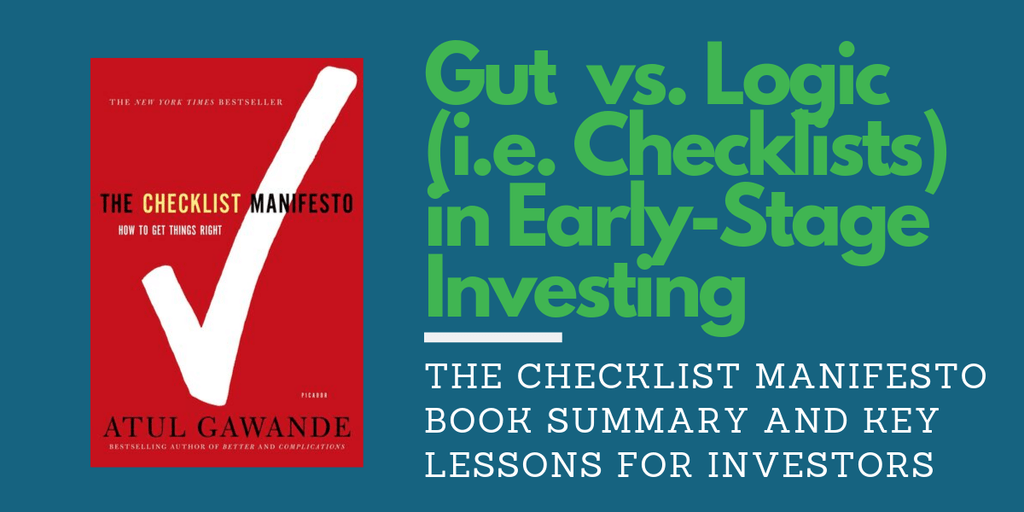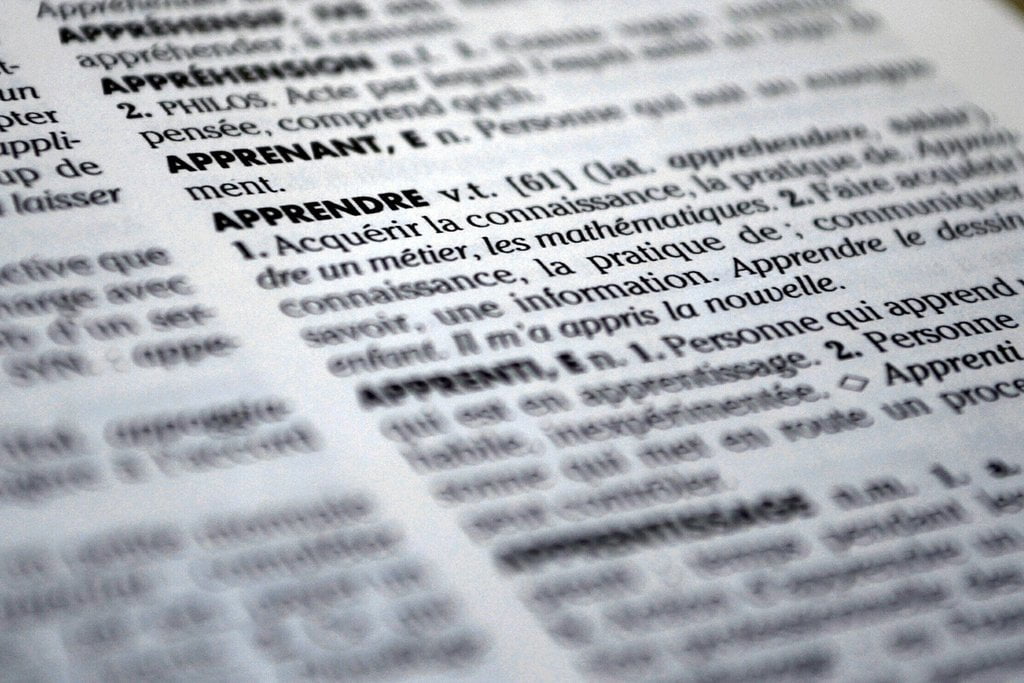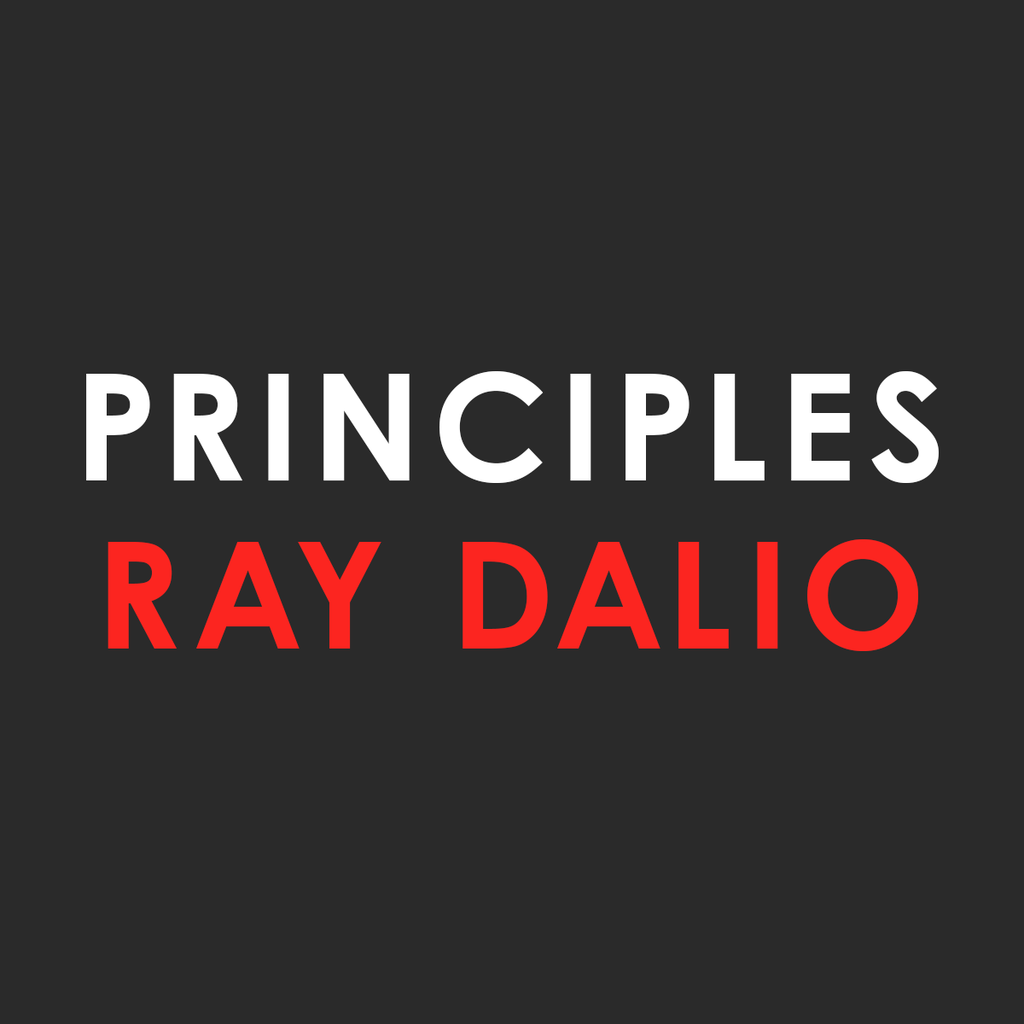Gut vs. Checklists – Which is Better for Startup Investment Decisions?

What do surgeons, airline pilots, builders of skyscrapers and investors have in common? While these experts are among the most highly-skilled and specialized in the world, they may be able to benefit from a simple tool that has been around for centuries.
That tool is a checklist.
Today’s book review will cover some of the key takeaways and lessons for investors from the book The Checklist Manifesto by Atul Gawande.
Stick around until the end to get your FREE Crowdfunding Investor Due Diligence checklist.
Do checklists help investors?
Angel investors are divided into two camps when making investment decisions. First, there are the angels who use their “gut” instincts to assess a founder. These investors make their investment decisions based on their intuition or “gut feel”, sometimes after a single meeting with the founder.
Second, there are angels who rely on objective criteria, and sometimes even checklists, to make investment decisions. Instead of trying to internally process all the variables and make a decision, they have a more organized methodology for evaluating potential investments.
Which of these two approaches will result in better investment outcomes?
To assess which of these approaches is best for the equity crowdfunding investor, we will look at the question from the perspective of a surgeon and the author of the book The Checklist Manifesto.
Why do humans fail?
For outcomes that are within our control (i.e. not due to luck or outside factors), two primary reasons for human failure are:
- Ignorance – “…we may err because science has given us only a partial understanding of the world and how it works.” -Atul Gawande
- Ineptitude – “…in these instances the knowledge exists, yet we fail to apply it correctly.” – Atul Gawande
An example of ignorance is trying to predict the weather next weekend or the path of a hurricane. We have models that can provide likely outcomes, but science doesn’t have a definitive grasp on all the variables that can impact the weather with certainty. In the investing world, this is like trying to predict whether the stock market will end higher or lower in a week (or a month, or a year).
Ineptitude, on the other hand, is the doctor who could have prescribed the correct antibiotic to stop a routine infection, but failed to correctly diagnose the patient based on what is known. Or the investor that missed all the red flags on the company’s balance sheet and lost their entire investment when the company went belly-up.
We can’t put what we don’t know into a checklist. Thus, a checklist cannot address the ignorance issue; unless you are a novice, in which case a checklist can teach you a thing or two.
The best use of a checklist is to prevent ineptitude. It helps to prevent skipping over steps that seem common or routine but are easily overlooked.
What causes ineptitude in today’s world?
The two biggest causes of ineptitude in human decision-making are:
- “The fallibility of human memory and attention, especially when it comes to mundane, routine matters…”
- E.g. Trying to remember the food you have cooking on the stove when the phone is ringing and your kids are crying – all at the same time.
- “…that people can lull themselves into skipping steps even when they remember them.”
- E.g. Your annual health checkup and bloodwork have been uneventful and normal for the past 10 years, so why would there be any issues this year?
In the context of startup investing, think about due diligence. Assume that 19 times in a row you uncover zero issues with businesses’ articles of organization and legal paperwork. You could easily trick yourself into thinking that verifying such information is a waste of your time.
However, when you uncover that shortcoming on the 20th startup, it could be the difference between making a potentially good investment and losing all your money.
As we’ll discuss, a well-designed checklist (and that’s a key point – not just any checklist) can help prevent both causes of ineptitude in today’s busy and complex world.
The world is shifting from ignorance to ineptitude
“Know-how and sophistication have increased remarkably across almost all our realms of endeavor, and as a result so has our struggle to deliver on them.” -Atul Gawande
Whether you go back 5, 50, or 500 years, one can marvel at how much more we know (or at least think we know) and understand about our world today. We are on the brink of new missions to space, self-driving cars, computers that can outsmart humans, and many other exciting discoveries.
Because of specialization and sharing in today’s economy, the world has become infinitely more complex.
Take the seemingly simple computer mouse. We use it daily and yet we take it for granted. As Matt Ridley, author of The Rational Optimist points out, “…there’s nobody on the planet who knows how to make a computer mouse. Quite literally.”
Do you know how to grow the coffee, which is consumed by the oil rig hand, who mined the oil to turn into plastic, to give to the manufacturer, who builds to the design from the electrical engineer, and on and on?
If no single individual can build a “simple” computer mouse, how on earth are we able to build engineering marvels such as 150+ story skyscrapers?
The world is more complex and specialized today than ever before in humankind’s history.
The flipside is that information is more accessible than ever before in history.
The shift in our errors has recently transitioned from primarily ignorance (i.e. not knowing) to ineptitude (i.e. not applying known knowledge correctly).
This is not to say that the human species has nothing left to learn. However, with information instantly accessible at our fingertips or via voice command, the shift from ignorance to ineptitude can’t be ignored.
And the busyness of life, email, social media, travel and more are constantly adding distractions that make ineptitude even more likely.
The question becomes – how can we protect against ineptitude?
To checklist or not to checklist? That is the question (what the evidence says)
“Avoidable failures are common and persistent, not to mention demoralizing and frustrating, across many fields—from medicine to finance, business to government. And the reason is increasingly evident: the volume and complexity of what we know has exceeded our individual ability to deliver its benefits correctly, safely, or reliably. Knowledge has both saved us and burdened us.” – Atul Gawande
We’ve established that we live in a world that is more complex than ever before, but where information is more accessible than ever before.
Can checklists help us in making better decisions? And if so, in what domains do they improve outcomes?
Gawande argues in his book that checklists do in fact result in better outcomes, whether the practitioner is a novice or an expert.
Checklists in the Operating Room

Take the case of surgeons in the operating room. No one would argue that surgeons are highly-trained, highly-skilled, and take their jobs seriously.
Gawande – a surgeon himself – writes how many hospitals and surgeons initially rejected (and still do) the use of a checklist.
How would you feel if someone told you that they were trying to boil down your job to a few items on a checklist?
“We may admit that errors and oversights occur—even devastating ones. But we believe our jobs are too complicated to reduce to a checklist.” – Atul Gawande
As previously discussed, the main reasons for failure today aren’t due to ignorance, but due to incorrectly applying what is already known. This occurs because things have become so complex.
While many surgeons resisted the use of a checklist (and still do), the results of using checklists in various hospitals in October 2008 speak for themselves:
“The final results showed that the rate of major complications for surgical patients in all eight hospitals fell by 36 percent after introduction of the checklist. Deaths fell 47 percent. The results had far outstripped what we’d dared to hope for, and all were statistically highly significant.”
The checklist helped across the board, regardless of country, doctors’ experience, budget of the hospital, or any other factors.
Checklists aren’t only effective in hospitals, though. Let’s look at some other areas where they can improve outcomes.
Checklists in the Air

One of the most widely recognized applications of mandatory checklists is the aviation checklist used by pilots.
With many lives at stake and ever-increasing complexity on the flight deck of modern airliners, checklists provide one way to ensure that pilots don’t miss any critical steps. Especially when the proverbial sh*t (e.g. birds) hit the fan (e.g. the jet engine), as in the case of Captain Sully in the “Miracle on the Hudson” flight.
Checklists allow pilots to maintain a level-headed approach during any situation, whether it’s a mundane takeoff procedure or an emergency landing.
With such extensive experience with checklists, what are some key takeaways from the aviation checklist that can be applied to other fields?
Characteristics of a good (or bad) checklist
“Bad checklists are vague and imprecise. They are too long; they are hard to use; they are impractical. They are made by desk jockeys with no awareness of the situations in which they are to be deployed. They treat the people using the tools as dumb and try to spell out every single step. They turn people’s brains off rather than turn them on.
Good checklists, on the other hand, are precise. They are efficient, to the point, and easy to use even in the most difficult situations. They do not try to spell out everything—a checklist cannot fly a plane. Instead, they provide reminders of only the most critical and important steps—the ones that even the highly skilled professionals using them could miss. Good checklists are, above all, practical.” – Atul Gawande
The aviation industry recognizes that checklists are not intended to spell out every single step of a task.
What is not included on checklists can be as hotly debated as what is included. Why is that?
First, if checklists included every single instruction, checklists would be so long and complex that people wouldn’t use them (i.e. not practical).
And where do you draw the line on specificity with such a checklist? E.g. Step 1: Breathe in. Step 2: Breathe out. Step 3: Raise hand with pen. Step 4: Apply pressure on paper. Step 5: Make downward stroke.
You must assume a certain level of competence of the operator of the checklist.
Second, by trying to specify every single step, it leaves no room for human judgement, creativity or improvisation.
Take the example of an artist creating a work of art. If you list out each and every step of creating a painting, there would be no room for creativity. It’s what you don’t specify that allows the talent and expertise of the artist to come in.
Thus, the focus is on what the most commonly overlooked and/or crucial steps of the process are.
Lastly, a checklist must be a living document that evolves over time. Just as the NTSB and Boeing continually make improvements to aviation checklists, we should look at feedback that improves our decision-making processes and incorporate the relevant points on our checklist.
Applying checklists to startup investing
The Checklist Manifesto presents a great deal of evidence that checklists improve the outcomes – even for experts – in fields such as medicine, aviation, and construction. But does it apply to other fields such as finance, law, government, and more?
Gawande states that “…it is true well beyond medicine. The opportunity is evident in many fields—and so also is the resistance. Finance offers one example.”
Many people – some prominent angel investors and venture capital firms included – gawk at the thought of using a checklist to try and evaluate investments.
It’s important to keep in mind that we aren’t trying to come up with a formula that works in all situations (just as an aviation checklist doesn’t allow you to fly the plane). Instead, we are creating a tool to help investors improve outcomes in today’s complex world.
So how might checklists be applied to screening early-stage investments?
Five potential benefits of using checklists to make investment decisions are:
- Preventing psychological hijacking and allowing for dispassionate analysis
- “Neuroscientists have found that the prospect of making money stimulates the same primitive reward circuits in the brain that cocaine does. And that, Pabrai said, is when serious investors like himself try to become systematic. They focus on dispassionate analysis, on avoiding both irrational exuberance and panic.”
- Using the “airline captain” VC approach for evaluating founders, as discussed in Geoffrey Smart’s PhD on Human Capital Valuation in VC, led to vastly superior investment outcomes
- Smart’s dissertation showed that having a logical, checklist-like approach to VC investing led to 80% IRR investment outcomes, compared to less than 30% IRR outcomes for other, less-objective methods (e.g. using your “gut”).
- Preventing yourself from slipping into mediocrity
- “Forty-nine times out of fifty…there’s nothing to be found. ‘But then there is.’”
- Improving your outcomes with no increase in skill – regardless of whether you are a novice or an expert
- With Regulation Crowdfunding only being around since 2016, no one can claim to be an “expert” in the field today; however, there are lessons that we can take from angel investing and VC investing and apply to early-stage startups in Reg CF
- Providing a process that you can continually refine and improve upon
Does the checklist help real investors, though?
From one anonymous investor:
“The benefits of making fewer mistakes seemed obvious. And in fact, using the checklist did increase the up-front work time. But to his surprise, he found they were able to evaluate many more investments in far less time overall.” -Atul Gawande
The Checklist Manifesto Book Summary
“We have an opportunity before us, not just in medicine but in virtually any endeavor. Even the most expert among us can gain from searching out the patterns of mistakes and failures and putting a few checks in place. But will we do it? Are we ready to grab onto the idea? It is far from clear.” -Atul Gawande
In case it isn’t already apparent, I am a huge believer in checklists. I use them myself for investing. But I also use them for engineering.
In my last job as an engineering leader at a large enterprise, we created checklists to assist the engineers in their design process. Many of the engineers resisted (and still do to this day), but those who accepted the checklist approach were able to see that it added value. The engineers who realized that we weren’t trying to tell them how to do their job came to be huge proponents of the checklists. And there is no doubt that the checklists prevented more than a few potential embarrassments or costly mistakes in front of customers.
Whether you are a lawyer, doctor, engineer, pilot, dentist, accountant, investor, fast food worker, or anything in between, I highly recommend you grab a copy of The Checklist Manifesto and ask yourself how checklists may be able to improve outcomes in your organization – and in life.
Download your free startup investor due diligence checklist
As Gawande mentions in the book, even airlines will take the mandated checklists from the FAA, and then modify them to suit their own needs.
To help crowdfunding investors get started, we have created a Crowdfunding Investor Due DIligence checklist. It is completely free – just create a free Crowdwise account and then log in to the member-only resources page to download your copy.
While this checklist provides a starting point, you should adapt this checklist for what best suits your own investment objectives and experience.
Do you have any critical investment screening questions that you use on your own screening checklist? Feel free to share them in the comments below so that other investors can benefit from your knowledge!






Responses